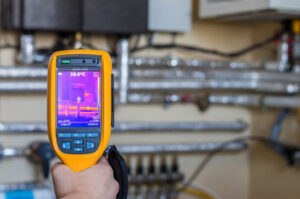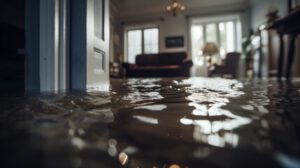Leak detection is a critical part of any water management system. It protects against environmental damage and costly repairs, as well as loss of valuable materials.

If you think you have a leak, shut off the water valve and walk around your property. Look for soft muddy areas and grass that is greener or growing faster than other areas. Visit https://www.leakops.com/ to learn more.
A sonic leak detection system uses high-frequency sound waves to identify the presence of a gas leak. These waves are picked up by a transducer and converted into a readout that can be understood by technicians. This technology is useful for locating and identifying the source of the leak in industrial facilities, where many different gases are present. It also helps to prevent explosions and other safety hazards.
The technology is designed to locate leaks quickly and accurately. It can be used on all types of pipes, including those made from plastic or metal. Its accuracy allows it to detect leaks at a very early stage, which is crucial for preventing hazardous environmental conditions. Leaks that occur on pipelines and in storage tanks can be dangerous for both the environment and human health. A sonic leak detector can help identify leaking gas and determine the location of the leak in a short amount of time.
Sonic can also be used to test the seal strength of packaging. It can be a useful tool for inspecting food containers, as it can identify weak areas in the seal that are susceptible to breakage. This is a critical part of the testing process for manufacturers, as it can reduce costs and ensure that products are safe to use.
A sonic leak detector is a great way to protect your home from damage caused by water leaks. It can be set to monitor your house around the clock and warn you when there is a problem. It can even shut off your water supply if necessary. It can also alert you to unusual water patterns and save you a lot of money.
Unlike other devices, Sonic uses hybrid HD ultrasonic TM technology to check up on your home more than half a million times per day. This means it can detect a leak almost anywhere in the home, and warn you via its handy app. It can also be used to track water usage, so you know which appliances are using the most water. It can even track your family’s and friends’ water use, and you can nominate a neighbor or friend to receive notifications if you’re going away for a while.
LiDAR leak detection
Using LiDAR to detect methane leaks can help reduce carbon emissions and ensure a safe environment. This technology uses laser-based imaging to spot leaks in the air from an airplane’s perspective. It can also be used for other natural gas pipelines, petrochemical facilities, and other industrial sites. This technique is particularly useful for detecting leaks that are difficult to find with other methods.
A laser pulse is emitted from the sensor and reflected from objects above and below the ground surface. Each reflection splits the original laser pulse into multiple returns, which are analyzed by the system. These returns are post-processed into highly accurate georeferenced point data. The resulting point cloud is a 3-D point map of the surveyed area. The attributes of these points can vary depending on the attributes selected during the scanning operation.
One of the most popular applications of airborne LiDAR is for pipeline inspections. The ALPIS (Airborne LiDAR Pipeline Inspection System) project is aimed at developing an autonomous airborne system that can locate and map leaks associated with natural gas and hazardous liquid pipelines. The system can survey large areas faster and at a lower cost than traditional pipeline inspection techniques.
In addition to the ability to identify methane leaks, this technology can also be used to measure the distribution of the leaking gas over an area. The distribution is recorded as a waveform, and peaks in the waveform represent areas where more energy is reflected than others. This is important for identifying the location of the leak and quantifying its magnitude.
This technology has many potential applications, but is especially important for reducing methane emissions. Methane is a powerful greenhouse gas, and reducing its emissions is a major priority. The new methane detection technology developed by Bridger Photonics is a great tool to do just that.
The company’s Gas Mapping LiDAR technology can detect methane leaks from the air, which can be mapped and pinpointed to facilitate repair work. The technology was recently approved as an ALARM (Area of Lifeline and Other Risk Management) Technology by the Division of Environmental Protection, and it is positioned to meet proposed EPA rules for methane emissions. The gas industry will be able to earn credits for methane emissions discovered by the system and verified or repaired within a certain time frame. VIGO offers a variety of high-performance infrared detectors, which can be utilized to monitor gas concentrations.
Infrared leak detection
Using thermal imaging technology, infrared leak detection can pinpoint the source of a water leak. It works on the principle that most materials emit or absorb infrared radiation, which can then be detected by specialised instruments. This technique is highly useful in industrial settings, where detecting leaks quickly can reduce downtime and help improve production efficiency.
Infrared leak detection is non-contact and non-invasive, which means that it can be used on a variety of surfaces, including rough or textured ones. This can be particularly helpful in identifying leaks under sinks, behind walls, or in other difficult-to-reach places. It is also a great choice for locating hazardous leaks, as it can detect gases without risking the safety of personnel or equipment.
In addition to being non-invasive, infrared leak detection is a fast and cost-effective method of locating hidden leaks. Infrared cameras can scan large areas or equipment in a short period of time, and the results are provided immediately. This helps minimise downtime and can save money by reducing the need for labour-intensive repairs. Infrared leak detection can also be used to scan the condition of a piece of equipment, such as a boiler or air conditioning system, which can identify potential problems before they develop into serious issues.
An infrared camera uses long-wave infrared to detect temperature variations and then displays them on a screen or heads-up display. It is important to choose a thermal camera with a wide temperature range to ensure that you can detect any significant changes in heat. Some cameras even come with a built-in thermometer that can display the current ambient temperature on the screen.
It is important to remember that interpreting infrared photos requires a certain level of skill and training. For example, you must be able to recognise when the temperature changes are caused by something other than a leak, such as drafts or inadequate insulation. In addition, it is crucial to take notes and voice record the steps you are taking while inspecting the area. This will make it easier to interpret the photos later on. The Fluke iRimager has a feature called IR PhotoNotes that allows you to record these notes and store them with the thermal images.
Acoustic leak detection
Acoustic leak detection is a cutting-edge method that uses sound to pinpoint the exact location of a water leak. It relies on acoustic waves that are produced by the vibrations created when water escapes from a pipe under pressure. This unique noise is picked up by microphones and sensors and is analysed to determine the severity of the leak. These sensors can also be used to identify the source of a leak by determining where the loudest sound is coming from.
The technology behind acoustic leak detection is simple and reliable. It requires no direct contact with the system being monitored and can be used to detect both steady-state and transient conditions. Its non-intrusive nature makes it an excellent option for detecting leaks in pipes, tanks, and other pressurised systems.
Leaks create a unique sound that is distinct from other sounds in the water pipeline system. The frequency of the sound varies depending on the size and location of the leak. Smaller leaks produce a higher-frequency sound, while larger ones produce a lower-frequency sound. Acoustic leak detection devices use specialized microphones to capture these sounds and locate the leaks based on their characteristics.
In addition to its effectiveness, acoustic leak detection is cost-effective and environmentally friendly. It is an ideal solution for water utilities, as it can reduce operational costs by minimizing water loss. Moreover, it can cut leak detection work time in half and eliminate the need to dig up and inspect pipes physically.
Sonic leak detectors are easy to operate and can be used by professionals of all ages. They are designed with user-friendliness in mind and come with intuitive interfaces, making them simple for anyone to understand. Some even have touchscreen displays that allow users to navigate their features. Regular calibration is recommended to account for changes in ambient temperature and sensor drift.
Water pipe leaks can cause major damage to the structure of a building and can also lead to high utility bills. Using acoustic leak detection allows you to find the exact location of a leak quickly and accurately, thus reducing the amount of water that is being wasted. This method is highly effective and can be used in a wide range of applications, including residential, commercial, and industrial settings.
